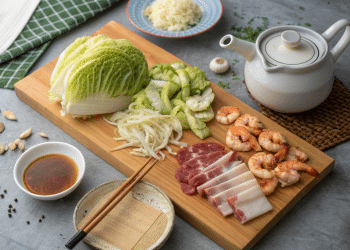Let’s be real, when you think of Italian desserts, you probably picture rich tiramisu, golden cannoli, or that dreamy scoop of pistachio gelato. But lately, something fresh has taken over dessert displays from Rome to Milan: desserts featuring the mint green color in Italian desserts that are as eye-catching as they are delicious.
Why mint green? It’s cool, it’s calming, and it practically screams “eat me” in the prettiest way possible. The color doesn’t just catch your eye, it’s tied to freshness and flavor, especially when it comes to mint, basil, and pistachio.
Origins of Mint in Italian Culinary Tradition
Mint has ancient roots in Italy. Roman writings mention mentha as a healing herb, and medieval monks cultivated it for medicine. But over time, it moved from the apothecary into the kitchen.
By the Renaissance, mint showed up in both savory sauces and sweet dishes. Paired with citrus, nuts, and even chocolate, it slowly made its way into traditional desserts.
You’ll Also Like:
How to Make a Ginger Bug Recipe for Naturally Fermented Sodas
Cheese and Bacon Cob Loaf Recipe Guide
Popular Mint Green Italian Desserts
Mint Gelato
Ah, the classic. Mint gelato is a favorite summer treat across Italy. It’s smoother and less sugary than American ice cream—and the mint flavor? Subtle, often blended with dark chocolate chips.
Pistachio-Mint Panna Cotta
A silky panna cotta that uses pistachio for nuttiness and mint for a cool finish—this combo is not only delicious but also naturally creates a soft mint green hue. It’s visually stunning and incredibly refreshing.
Mint Tiramisu Variations
Yes, it’s a thing! Some trendy cafes are serving up mint tiramisu, layering mint-infused mascarpone between espresso-dipped ladyfingers. The green twist adds a modern vibe to this old-school fave.
Mint Semifreddo
Think of this as gelato’s elegant cousin. Frozen but creamy, mint semifreddo is light and airy, often served with dark chocolate or fresh berries. It’s a go-to for fancy dinner parties.
Mint-Infused Cannoli
You’ve had cannoli with ricotta, but have you tried it with a mint mascarpone filling? Dust it with pistachio crumbs and drizzle with dark chocolate—it’s as luxe as it sounds.
Natural vs Artificial Coloring in Italian Sweets
Italians are big on natural ingredients. So while some mint desserts get their green from food coloring, many lean on real herbs, matcha, spirulina, or pistachios for that green hue.
Traditional Italian Preference for Natural Ingredients
From nonnas to Michelin-starred chefs, Italians pride themselves on simplicity. Fresh mint leaves, when steeped or pureed, lend both flavor and color.
The Role of Pistachio and Mint
Pistachio adds creaminess and a yellow-green base. Mint brings in brightness. Together, they create that iconic pale green shade we see in everything from tarts to gelato.
Mint Green: A Feast for the Eyes
With the rise of Instagram, mint green desserts are camera gold. The color pops against white plates, rustic backgrounds, or modern black slate. You’ll find them front and center in cafes from Venice to Sicily.
Plating Techniques in High-End Restaurants
Fine-dining chefs love playing with texture and color. Expect mint sauces painted in swirls, green foams, or pistachio dust sprinkled like fairy magic.
Mint Desserts in Weddings & Holidays
Mint green desserts are also trending at weddings. Mini mint panna cottas in shot glasses, mint macarons, and even mint tiramisu wedding cakes are becoming staples.
How to Make Mint Green Desserts at Home
Want to try it yourself? Here’s a quick guide:
Choosing the Right Mint
Spearmint is sweeter and milder; peppermint is bolder. Use fresh spearmint for gelato and panna cotta. Peppermint works better in chocolate-based treats.
Achieving the Perfect Shade
Blanching mint leaves before blending keeps their color vibrant. You can also infuse the cream with mint, then blend it with pistachio paste for a natural green.
Flavor Balance Tips
Mint can overpower easily. Keep it subtle. Combine with creamy textures (like ricotta or mascarpone) to mellow it out.
Mint and Pistachio – Italy’s Green Power Couple
They’re like the Beyoncé and Jay-Z of Italian flavors. Together, mint and pistachio hit the perfect balance of earthy and fresh.
Common Pairings
- Mint pistachio gelato
- Mint pistachio cake
- Minty pistachio cream in éclairs
Why They Work
It’s all about contrast. Pistachio brings fat and nuttiness. Mint brings a cool lift. Together? Bellissimo.
🇮🇹 Regional Differences Across Italy
Northern Italy
You’ll find more mint panna cottas and semifreddos, especially in Milan and the Lake Como region.
Southern Italy
Sicily leans into mint-pistachio cannoli and granita. The use of fresh herbs is more rustic, with backyard mint leaves playing a starring role.
The Symbolism of Green in Italian Culture
In Italy, green symbolizes new beginnings, spring, and vitality. It’s no surprise that mint green desserts often appear at baptisms, spring festivals, and weddings.
Trending Mint Green Desserts in 2025
Here’s what’s hot this year:
- Mint ricotta cheesecake
- Vegan mint sorbet with basil drizzle
- Matcha-mint fusion tiramisu
- Mint-pistachio cruffins (yes, they exist!)
🌱 Healthier Versions of Mint Green Desserts
Vegan Mint Gelato
Made with coconut milk and sweetened with agave. Still creamy, still green.
Dairy-Free Mint Mousse
Avocado-based mint mousse is blowing up on social media.
Sugar-Free Options
Mint pairs well with stevia or monk fruit, making it perfect for low-sugar treats.
Mint green is more than just a pretty color—it’s a flavor, a feeling, and a fresh take on classic Italian desserts. Whether it’s swirled in a semifreddo or piped into a cannoli, this soothing shade is stealing the spotlight in Italian kitchens and patisseries. So next time you’re whipping up something sweet, consider going green—the Italian way.
❓ FAQs
1. What gives Italian mint desserts their green color?
Natural mint, pistachio, and sometimes matcha or spinach can give the green hue. Food coloring is used sparingly.
2. Are mint desserts popular in Italy year-round?
Yes, but they’re especially popular in spring and summer for their cooling effect.
3. Can you make mint green desserts without food coloring?
Absolutely! Use fresh mint leaves, pistachio paste, or spirulina for natural color.
4. What’s the difference between spearmint and peppermint in desserts?
Spearmint is sweeter and more subtle—perfect for desserts. Peppermint is bolder and more minty, often used with chocolate.
5. Is mint used in savory Italian dishes too?
Yes! It’s often used in Sicilian lamb dishes, salads, and even pasta sauces.














